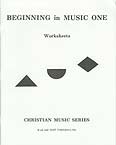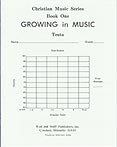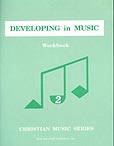Purchase these books from the
Music Textbooks at Milestone Books
Click on a course to see an overview and sample lessons.

Beginning in Music One is a set of 32 one-sided, tear-out worksheets designed to teach two sets of musical characters: the syllable shapes and kinds of notes.
Shapes tell the syllable name (Do, Re, Mi, etc.) and are not related to length of tone. In teaching the syllable shapes, we have ascribed to each syllable a particular color which expresses the general feeling of that tone. The worksheets drill tracing shapes, coloring shapes, choosing particular shapes from varieties of shapes, and matching the shapes to their names. The emphasis at this level is on recognition of shapes and their names.

Beginning in Music Two has 36 one-sided, tear-out worksheets that review and drill syllable shapes and kinds of tones. This course is more advanced than the Grade 1 course in that pupils learn to draw shaped notes and characters showing note values, and they are drilled in writing the names and values of the notes. Rests are included in Grade 2. Pupils learn to draw and label rests. Worksheets 10, 19, 30, and 34 are tests.

Thirty-six perforated worksheets in Beginning in Music Three prepare the pupils for Growing in Music, Book One (Grades 4 and 5). Note shapes, note values, and rests are reviewed. Various musical terms such as the scale, the staff, lines, spaces, and measures are taught in a simple manner. The last nine lessons introduce accidentals.




Can be used for grades 4 and 5.
Although Growing in Music assumes that the pupil can recognize characters such as notes, rests, and clef signatures, the six chapters cover the simplest elements of music and can be used for those who have had no previous instruction.
Such aspects as sound, tone properties, good singing habits, the various parts of the staff, the major diatonic scale, notes and rests, and rhythm are taught. There are questions at the end of each chapter for the student to answer.
Sight-reading exercises in the back ofthe book help the students to learn the scale and simple rhythm patterns. A sections of rounds and two-part songs is provided to help the students in harmonizing parts.




Developing in Music may be used for Grade 6 or 7, or a combination of grades. In this textbook with a durable, soft cover, each of the 6 chapters is divided into shorter lesson parts by subtitles. Each chapter ends with a set of study questions and a one-page account of a well-known hymn author.



In addition to reviewing and strengthening concepts taught in the lower levels, in Maturing in Music students will learn about characteristics of worthy hymn lyrics and church music, transposition of keys, reading round notes, the minor and pentatonic scales, notation of rhythm, dynamics, and song interpretation.
Click on a course to see an overview and sample lessons.